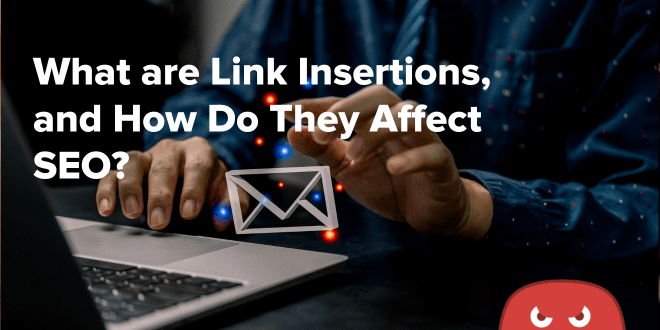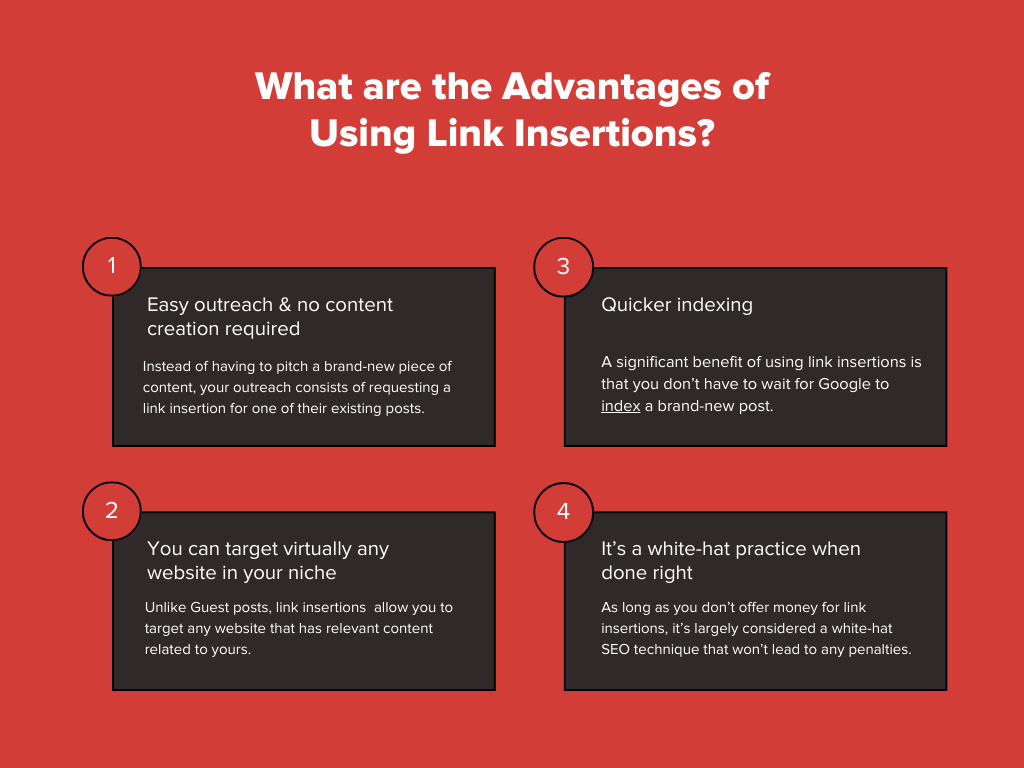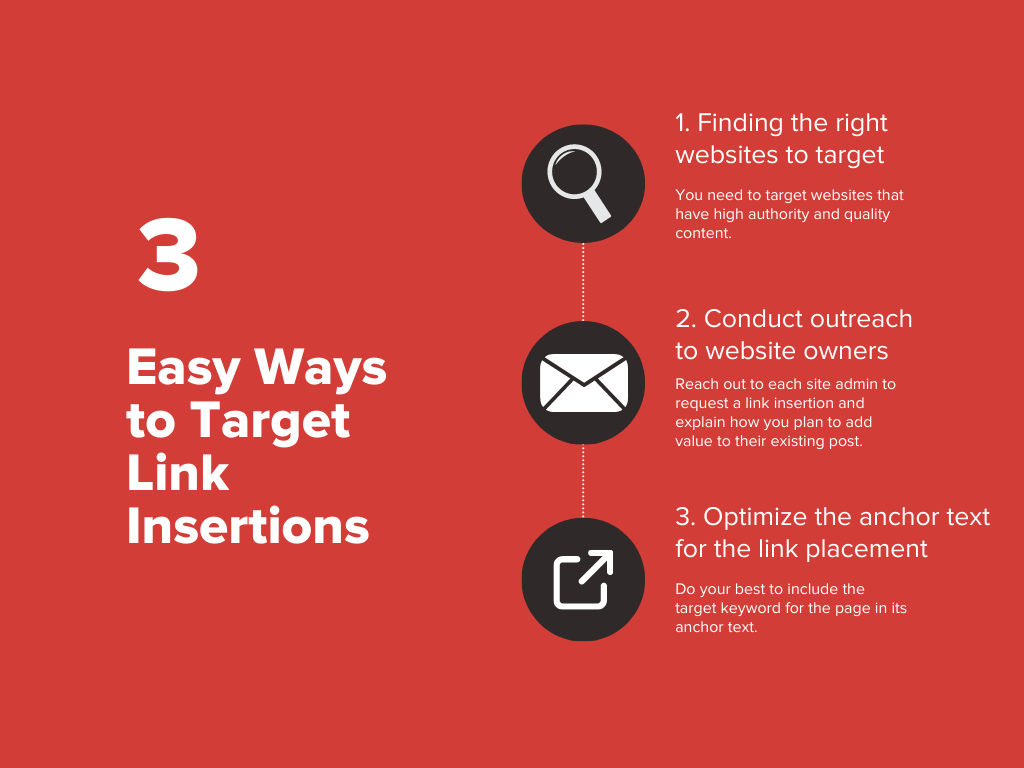Quick Links
Link-building strategies are still crucial for SEO, especially for campaigns on Google.
How do we know?
Research has found that the number of backlinks a web page has is directly correlated with the amount of organic traffic it’s able to generate.
There have also been countless other studies and experiments proving the connection between high-quality backlinks and top search engine rankings.
However, link building is also difficult and time-consuming, especially guest posting. That’s led to the recent surge in the popularity of link insertions.
What are link insertions?
Also called niche edits & link placements, a link insertion refers to placing one of your backlinks in an existing piece of content on a topically relevant website.
By conducting outreach to website owners, you can request that they insert one of your links into an existing article.
Link insertions are so popular because the outreach is quick, you don’t have to create any original content for them (as opposed to guest posts), and you can obtain high-quality links to boost your search engine rankings.
The challenge comes in how you convince site owners to insert one of your backlinks into an older piece (more on this in a bit).
As long as you follow white-hat link-building tactics, link insertions won’t land you in any hot water with Google.
Read on to learn more about link placements, including how to create a link insertion campaign for your website.
How Do Link Insertions Fit Into Link Building?
Link-building tactics have been a part of the search engine optimization process ever since the inception of Google, way back in the late 90s.
Backlinks, which are links pointing to your site from an external site, serve as ‘credibility votes’ toward the quality, authority, and trustworthiness of your content.
To a search engine like Google, if relevant domains with high authority and top-tier content are linking to your blogs, homepage, and service pages – it’s seen as a sign that your website is of the same caliber.
Notice that we said relevant domains, as you’ll want to acquire backlinks from related websites that publish similar content to yours.
If you obtain backlinks in different niches or industries, they won’t add much power (also called link juice) to your link profile.
The authority of the websites you target for backlinks also matters.
What’s that?
Domain authority score refers to an SEO metric developed by Moz (not Google) that predicts how likely a website is to rank on the SERPs (search engine results pages). It’s a score ranging from 1 – 100, with scores above 50 considered ‘good.’
While domain authority score isn’t an official Google ranking factor, it’s a fairly accurate way to assess the ranking power of a domain – especially if you’re considering targeting them for a backlink.
How important are backlinks for SEO on Google?
Next to on-page SEO, most experts agree the strength of your backlink profile is the second-most important ranking factor.
How link insertions gained popularity
For years, tactics like guest posting, creating infographics, and outdoing competitor content dominated most link-building services as their go-to methods for obtaining backlinks.
Link insertions were a thing, but they were largely seen as inferior to other methods like guest posting.
In fact, they went by the not-so-graceful name of link begging.
However, that’s changed in recent years, when SEOs realized that adding backlinks to existing pieces of content is actually a viable tactic that involves simple outreach and provides impressive results.
As long as the linking domain has topical relevance to your content and has decent authority, backlinks acquired through link insertions can boost your SERP rankings and online visibility.
Link insertions are now equally as popular (and effective) as other tried-and-true link-building tactics like guest posting or the skyscraper technique.
What are the Advantages of Using Link Insertions?
Now that you know more about the history of link insertions, why should you bother using them?
After all, if you’re already writing guest posts and targeting HARO placements, is it really worth adding link insertions into your repertoire?
It’s definitely worth adding link insertions into the mix, especially since they involve simple outreach, no content creation, and you can target a wide variety of websites – among other perks.
Here’s a look at all the reasons why you should start targeting link insertions for your SEO.
Quicker indexing
A significant benefit of using link insertions is that you don’t have to wait for Google to index a brand-new post.
Depending on the popularity of the website you’re writing for, it can take anywhere from several hours to several weeks for Google to index a new guest post.
Unless you’re writing a guest post on a behemoth site like Wikipedia (which usually receives same-day indexing for new content), you’ll have to wait quite a while for your new guest post to appear in the SERPs.
That means you’ll face a long wait between publishing the post and seeing its impact on your SEO profile.
Link insertions are different because you’re adding a backlink to an existing page within Google’s index.
The result?
You won’t have to wait for your link profile to receive the sweet link juice from your newly acquired backlink. That means link insertions can provide near-instantaneous boosts to your SERP rankings, which is a big reason why they’re so powerful.
You can target virtually any website in your niche
Guest posts are pretty limited in that not every website accepts guest posts.
That seriously limits your options when looking for websites to target for guest blogging.
This problem gets exacerbated for smaller niches that already don’t have many websites posting regular blogs.
Link insertions don’t have this limitation, as you can target any website that has relevant content related to yours.
For instance, let’s say you’re in the gardening niche, and you find a gardening site that briefly mentions biodynamic gardening in one of their articles – which you happen to have an in-depth guide for on your website.
This is a perfect situation for targeting a link insertion.
Since the article only mentioned biodynamic gardening in passing, your ultimate guide provides a meaty resource for further reading.
That will improve their user experience, and it will update the content and make it fresh again. This is beneficial for the webmaster, as it gives an aging piece of content a chance to generate some more organic traffic (and maybe even a few leads and sales).
The best part?
You don’t have to worry if the website in question accepts guest posts or not, so you won’t have to waste such a golden opportunity.
It’s a white-hat practice when done right
As long as you don’t offer money for link insertions, it’s largely considered a white-hat SEO technique that won’t lead to any penalties.
That’s because paying for link insertions would be considered a link scheme and could potentially land you in hot water with Google – which will negatively affect your SERP rankings.
As long as you offer value to the website in the form of updated content or exchanging link insertions/guest posts – you’re in the clear.
The example listed above, where you add a link to an ultimate guide that enhances the existing content, is one of the best ways to target link insertions without attracting negative attention.
Google recently released a Link Spam Update in late 2022 that cracked down on paid backlinks, so it’s best to avoid offering money for links outright.
Instead, do what you can to update and add value to older posts on relevant websites.
How to Target Link Insertions in 3 Easy Steps
Randomly selecting websites for link insertions won’t cut it, so you’ll need to develop a game plan if you want to find success.
The typical link insertion strategy goes as follows:
- Finding relevant websites with desirable SEO metrics to target
- Conducting an outreach campaign
- Placing the links with optimized anchor text
Let’s take a closer look at each step.
Step #1: Finding the right websites to target
Relevant links matter to Google, so you don’t want to link to your website in inappropriate places.
Even when you find an appropriate website, you can’t just add a link to any page you find.
Rather, you need to uncover the best opportunities for link insertions within their content.
Remember the gardening website example that linked an ultimate guide to a relevant article?
Those are the types of opportunities you need to keep an eye out for when browsing websites within your niche.
Do they mention any products or services you sell? Do you have any in-depth pieces that provide more detail for something they only mention in passing?
Also, you need to target websites that have high authority and quality content.
Otherwise, you may end up acquiring a backlink from a website with less-than-favorable SEO metrics, which won’t do you any favor on the SERP rankings.
You can use our free SEO audit tool to quickly uncover crucial SEO metrics for any website, including the following:
- Link profile
- On-page SEO
- Performance
- Usability
- Social presence
- Many more
Once you’ve uncovered a handful of high-quality websites to target, you can move on to the next step.
Step #2: Conduct outreach to website owners
Now it’s time to work some email magic and reach out to each site admin to request a link insertion.
Doing things the white-hat way, you’ll need to include how you plan to add value to their existing post here.
That, or offer value in another way, such as trading link insertions or allowing them to write a guest post on your site.
Whichever method you choose, remember to keep your outreach emails short, simple, and to the point (there’s no need to beat around the bush).
Remember, if your website has pristine SEO metrics (lightning-fast loading speed, good domain authority, quality content, etc.), it’ll be easier to convince site owners to add your links to their content.
Bearing that in mind, you can consult our extensive on-page SEO and technical SEO guides to make your website a lean, mean SERP ranking machine.
Step #3: Optimize the anchor text for the link placement
Anchor text, or the text you use to mask the naked URL, is another important ranking factor to Google.
In particular, anchor text needs to be informative, relevant, and keyword-rich.
No matter what you do, avoid generic anchor text at all costs.
Phrases like ‘buy now’ and ‘click here’ are considered far too generic.
That’s because they don’t give the reader a sense of what to expect when clicking the link. Anchor text is the most helpful when it describes the page it links to.
You should also do your best to include the target keyword for the page in its anchor text, as Google’s crawler bots will pick up on it.
Concluding Thoughts: What are Link Insertions?
Link insertions are a great link-building tactic you can use today with the right approach.
Placing links in existing articles speeds up the indexing process, simplifies outreach, and saves you from having to create new content for backlinks.
Do you need help developing a winning link-building strategy for your website?
Then you need to check out our link insertion services from The HOTH. Our link-building gurus know what it takes to build outstanding link profiles, so don’t wait to get in touch.










I really thought that link insertion is paid for I have received email replies that have stated the price for link insertion instead. So every time link insertion is mentioned, my mind automatically brands it as paid only. It did not occur to me that it can be in exchange for something else other than money.
Thanks for sharing, this is quite a good read by the way, and is helpful as well.
nice blog
good one